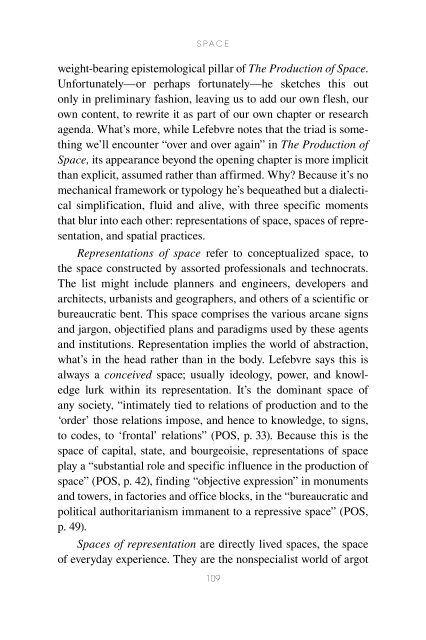Henri Lefebvre: A Critical Introduction - autonomous learning
Henri Lefebvre: A Critical Introduction - autonomous learning
Henri Lefebvre: A Critical Introduction - autonomous learning
You also want an ePaper? Increase the reach of your titles
YUMPU automatically turns print PDFs into web optimized ePapers that Google loves.
s p a c e<br />
weight-bearing epistemological pillar of The Production of Space.<br />
Unfortunately—or perhaps fortunately—he sketches this out<br />
only in preliminary fashion, leaving us to add our own flesh, our<br />
own content, to rewrite it as part of our own chapter or research<br />
agenda. What’s more, while <strong>Lefebvre</strong> notes that the triad is something<br />
we’ll encounter “over and over again” in The Production of<br />
Space, its appearance beyond the opening chapter is more implicit<br />
than explicit, assumed rather than affirmed. Why? Because it’s no<br />
mechanical framework or typology he’s bequeathed but a dialectical<br />
simplification, fluid and alive, with three specific moments<br />
that blur into each other: representations of space, spaces of representation,<br />
and spatial practices.<br />
Representations of space refer to conceptualized space, to<br />
the space constructed by assorted professionals and technocrats.<br />
The list might include planners and engineers, developers and<br />
architects, urbanists and geographers, and others of a scientific or<br />
bureaucratic bent. This space comprises the various arcane signs<br />
and jargon, objectified plans and paradigms used by these agents<br />
and institutions. Representation implies the world of abstraction,<br />
what’s in the head rather than in the body. <strong>Lefebvre</strong> says this is<br />
always a conceived space; usually ideology, power, and knowledge<br />
lurk within its representation. It’s the dominant space of<br />
any society, “intimately tied to relations of production and to the<br />
‘order’ those relations impose, and hence to knowledge, to signs,<br />
to codes, to ‘frontal’ relations” (POS, p. 33). Because this is the<br />
space of capital, state, and bourgeoisie, representations of space<br />
play a “substantial role and specific influence in the production of<br />
space” (POS, p. 42), finding “objective expression” in monuments<br />
and towers, in factories and office blocks, in the “bureaucratic and<br />
political authoritarianism immanent to a repressive space” (POS,<br />
p. 49).<br />
Spaces of representation are directly lived spaces, the space<br />
of everyday experience. They are the nonspecialist world of argot<br />
109
















